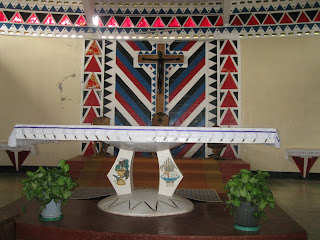The boarding students that remained on the school's premises during the break, the headmaster, and I escaped the "compound" to visit an open-air cultural museum east of Mwanza in Kisesea.
Open-air apparently meant "open skies" because on this particularly day the heavens opened up, and it rained heavily with hail en route to the museum. Recorded rainfall this month has made the area of Mwanza and its bordering regions uncharacteristically green and lush for this time of year. The rain has reeked havoc on the dirt roads which hurts the economy, but has provided well for the shambas/farms and has provided ample water for the cattle.
We bumped, rocked and traveled through flooded areas to finally reach the museum. Upon arrival we were welcomed by the sun but not for long!
The museum celebrates the rich culture of the Sukuma tribe. It was first established in 1954 by a Canadian Jesuit priest, Father David Clement, whose mission was to teach Catholicism and to combine these teachings with the Sukuma culture. Clement was nicknamed Fumbuka, meaning unexpected. Bujora Church located on the crest of the hill overlooking the museum is the church Clement established in 1952. It remains today as an important religious center of "Adaptation." It continues to teach the Catholic liturgy through indigenous cultural terms.
Traditionally, the Sukuma culture practiced their faith within the confines of their family compound. Prayers were directed to the creator of all things with hopes of bountiful rainfall for irrigation and for their "prosperity." Combining the two religious ideologies has strengthened the culture, and it is noted as the largest tribe in the region.
Pictured above is the altar inside the Bujora Church. The triangles painted on the walls of the church represent the hoe an important symbol of farming which further represents food and life. The triangles have also been related to the Holy Trinity; the Father, Son, and the Holy Spirit. The color red represents fire and life, black - the people of Africa, and blue - the coveted Lake Victoria of Tanzania.
 | |
| Tabernacle representing a chief's dwelling |
 | |
| Ambo, Neno La Mungu/Word of God |
 | ||||||||||||||||||||||||||||||||||||
Traditional Sukuma dwelling
|








Awesome colors and design! You could have just photoshopped that snake, you know! We would have believed you. Be well!
ReplyDeleteHi Liz! You caught my blog while I was adding and editing. Somehow, I mistakenly deleted the snake photos. The snake was quite an attraction particularly draped across my shoulders. Elite Sukuma dance troupes perform with live snakes. Dance? I barely moved which is how I dance anyway! Shy as a cucumber!
ReplyDeleteHi MaryJane,
ReplyDeleteIt's Sue, so happy to finally be able to write to you. Love reading your blog. My dearest friend Jill "Ms Technology" helped!!!